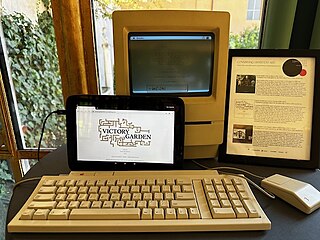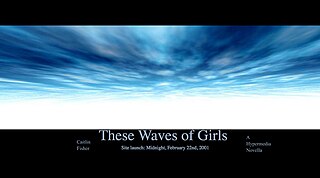Related Research Articles

Hypertext is text displayed on a computer display or other electronic devices with references (hyperlinks) to other text that the reader can immediately access. Hypertext documents are interconnected by hyperlinks, which are typically activated by a mouse click, keypress set, or screen touch. Apart from text, the term "hypertext" is also sometimes used to describe tables, images, and other presentational content formats with integrated hyperlinks. Hypertext is one of the key underlying concepts of the World Wide Web, where Web pages are often written in the Hypertext Markup Language (HTML). As implemented on the Web, hypertext enables the easy-to-use publication of information over the Internet.
Hypertext fiction is a genre of electronic literature, characterized by the use of hypertext links that provide a new context for non-linearity in literature and reader interaction. The reader typically chooses links to move from one node of text to the next, and in this fashion arranges a story from a deeper pool of potential stories. Its spirit can also be seen in interactive fiction.
Narratology is the study of narrative and narrative structure and the ways that these affect human perception. It is an anglicisation of French narratologie, coined by Tzvetan Todorov. Its theoretical lineage is traceable to Aristotle (Poetics) but modern narratology is agreed to have begun with the Russian formalists, particularly Vladimir Propp, and Mikhail Bakhtin's theories of heteroglossia, dialogism, and the chronotope first presented in The Dialogic Imagination (1975).
Ergodic literature is a term coined by Espen J. Aarseth in his 1997 book Cybertext—Perspectives on Ergodic Literature to describe literature in which nontrivial effort is required for the reader to traverse the text. The term is derived from the Greek words ergon, meaning "work", and hodos, meaning "path". It is associated with the concept of cybertext and describes a cybertextual process that includes a semiotic sequence that the concepts of "reading" do not account for.

Espen J. Aarseth is a Norwegian academic specializing in the fields of video game studies and electronic literature. Aarseth completed his doctorate at the University of Bergen. He co-founded the Department of Humanistic Informatics at the University of Bergen, and worked there until 2003, at which time he was a full professor.

Digital poetry is a form of electronic literature, displaying a wide range of approaches to poetry, with a prominent and crucial use of computers. Digital poetry can be available in form of CD-ROM, DVD, as installations in art galleries, in certain cases also recorded as digital video or films, as digital holograms, on the World Wide Web or Internet, and as mobile phone apps.
Electronic literature or digital literature is a genre of literature where digital capabilities such as interactivity, multimodality or algorithmic text generation are used aesthetically. Works of electronic literature are usually intended to be read on digital devices, such as computers, tablets, and mobile phones. They cannot be easily printed, or cannot be printed at all, because elements crucial to the work cannot be carried over onto a printed version.

A Thousand Plateaus: Capitalism and Schizophrenia is a 1980 book by the French philosopher Gilles Deleuze and the French psychoanalyst Félix Guattari. It is the second and final volume of their collaborative work Capitalism and Schizophrenia. While the first volume, Anti-Oedipus (1972), was a critique of contemporary uses of psychoanalysis and Marxism, A Thousand Plateaus was developed as an experimental work of philosophy covering a far wider range of topics, serving as a "positive exercise" in what Deleuze and Guattari refer to as rhizomatic thought.

afternoon, a story, spelled with a lowercase 'a', is a work of electronic literature written in 1987 by American author Michael Joyce. It was published by Eastgate Systems in 1990 and is known as one of the first works of hypertext fiction.
George Paul Landow was Professor of English and Art History Emeritus at Brown University. He was a leading authority on Victorian literature, art, and culture, as well as a pioneer in criticism and theory of Electronic literature, hypertext and hypermedia. He also pioneered the use of hypertext and the web in higher education.

Patchwork Girl or a Modern Monster by Mary/Shelly and Herself is a work of electronic literature by American author Shelley Jackson. It was written in Storyspace and published by Eastgate Systems in 1995. It is often discussed along with Michael Joyce's afternoon, a story as an important work of hypertext fiction.

Victory Garden is a work of electronic literature by American author Stuart Moulthrop. It was written in StorySpace and first published by Eastgate Systems in 1991. Victory Garden is one of the earliest examples of hypertext novels, and is notable for being very inventive and influential in its genre. It is often discussed along with Michael Joyce's afternoon, a story as an important work of hypertext fiction.
Stuart Moulthrop is an innovator of electronic literature and hypertext fiction, both as a theoretician and as a writer. He is author of the hypertext fiction works Victory Garden (1992), which was on the front-page of the New York Times Book Review in 1993, Reagan Library (1999), and Hegirascope (1995), amongst many others. Moulthrop is currently a Professor of Digital Humanities in the Department of English, at the University of Wisconsin–Milwaukee. He also became a founding board member of the Electronic Literature Organization in 1999.

Interactive design is a user-oriented field of study that focuses on meaningful communication using media to create products through cyclical and collaborative processes between people and technology. Successful interactive designs have simple, clearly defined goals, a strong purpose and intuitive screen interface.

Cybertext as defined by Espen Aarseth in 1997 is a type of ergodic literature where the user traverses the text by doing nontrivial work.

Kate Pullinger is a Canadian novelist and author of digital fiction, and a professor of Creative Writing at Bath Spa University, England.
Marjorie Coverley Luesebrink was an American writer, scholar, and teacher. Writing hypermedia fiction under the pen name M.D. Coverley, she is best known for her epic hypertext novels Califia (2000) and Egypt: The Book of Going Forth by Day (2006). A pioneer born-digital writer, she is part of the first generation of electronic literature authors that arose in the 1987–1997 period. She was a founding board member and past president of the Electronic Literature Organization and the first winner of the Electronic Literature Organization Career Achievement Award, which was named in her honor. Lusebrink was professor emeritus, School of Humanities and Languages at Irvine Valley College (IVC).
Astrid Christina Ensslin is a German digital culture scholar, and Professor of Dynamics of Virtual Communication Spaces at the University of Regensburg. Ensslin is known for her work on digital fictions and video games, and her development of narratological theory to encompass digital narratives. Ensslin is known for her critical scholarship on digital fictions and video games, and her development of narratological theory to encompass digital narratives.

These Waves of Girls is a hypermedia novella by Caitlin Fisher that won the Electronic Literature Organization's Award for Fiction in 2001. The work is frequently taught in undergraduate literature courses and is referenced in the field of electronic literature as a significant example of early multimodal web-based hypertext fiction, placing Fisher "at the forefront of digital writing".
References
- ↑ Pisarski, Mariusz (2023). "Diverse Mappings of Electronic Literature". Global Perspectives on Digital Literature. New York and Oxford: Routledge, Taylor and Francis Group. p. 45. ISBN 978-1-032-10351-8.
- 1 2 "34 North 118 West - 2002, by Jeff Knowlton, Naomi Spellman & Jeremy Hight". GPS Museum. Retrieved 18 September 2023.
- ↑ Ensslin, Astrid; Bell, Alice (2021). Digital Fiction and the Unnatural: Transmedial narrative theory, method, and analysis. Ohio State University Press. p. 76. ISBN 978-0814214565.
- 1 2 Dore, Christopher (February 2004). "Virtual Real-Space Museums: Innovation in Cultural Interpretation" (PDF). American Cultural Resources Association Newsletter. 10 (1): 7–8.
- ↑ Landow, George P. (2006). Hypertext 3.0: critical theory and new media in an era of globalization. Parallax (3rd ed.). Baltimore (Md.): Johns Hopkins University Press. pp. 247–250. ISBN 978-0-8018-8256-2.
- ↑ "34 NORTH 118 WEST". 34n118w.net. Retrieved 2023-10-16.
- ↑ "GPS Controlled Interactive Narrative, 34 NORTH 118 WEST". NOEMA - Technology & Society. 2002-12-13. Retrieved 2023-09-28.
- ↑ Interactive Digital Narrative: History, Theory and Practice. 9781138782396. 2015. ISBN 9781138782396.
- ↑ "20 and 21_Jeremy Hight: One-man Literary Artist and Theorist". bivoulab. 2020-09-04. Retrieved 2023-09-28.
- ↑ Aarseth, Espen (1997). Cybertext: Perspectives on Ergodic Literature (PDF). Johns Hopkins University Press i.
- ↑ Eskelinen, Markku (2012). Cybertext Poetics. International Texts in Critical Media Aesthetics. Vol. 2. London and New York: Continuum International Publishing Group. p. 34. ISBN 978-1-4411-2438-8.